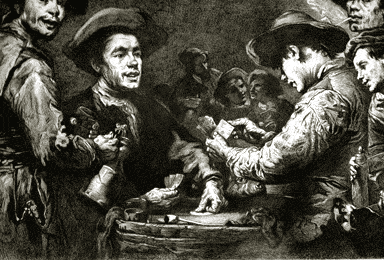|
|
Progress Publishing Co. |
|
|
The History of Poker |
|
|
Progress Publishing Co. |
|
|
The History of Poker |

![]()

![]()
The History of Poker
*******************************************************************
The History of Poker in the United States
European Predecessors in the History of Poker
Hoyle’s Description of the Early History of Poker
Main Developments in the History of Poker
*******************************************************************
The History of Poker in the United States
According to the few historical documents written by the writers, gamblers and a traveling comedian dated by 1830 – 1840s, the history of Poker in the United States started in 1810 – 1820s. At that time Poker appeared in its original and simplest form. That old American Poker was played with a 20-card deck by 4 players each dealt 5 cards. The players bet on who had the best hand among possible ranking hands of a pair, two pairs, threes, full and fours. The cards played included an ace, king, queen, jack and ten. The highest possible hand was four aces. The unbeatable hands were four aces and four kings with an ace. Drawing was not a part of the game. The flush and straight were not adopted yet as the ranking hands.
European Predecessors in the History of Poker
The history of poker did not start out of the thin air. The old American Poker of the early 1800s had few European ancestors. The name points to the most obvious predecessor - the French game of “Poque”. It was played in France since 17th century. English pronunciation turned poque into poker. Besides the name similarity, French poque had the same structure of the game in betting, hand rankings and bluffing. The difference was in the 32 cards in the deck instead of 20. The first game of American Poker is basically a 20-card version of the French Poque. Poque was brought to Louisiana by French colonists at the end of the 18th century. The gambling saloons of New Orleans and later Mississippi river boats were the places where Poker was born and the history of Poker began.
The genealogical roots in the history of Poker can be traced deeper into the history of gambling. French Poque itself was, most likely, a descendant of the 16th century German game of Pochspiel, in which the element of bluffing played an important role and the players could pass or open. It is also likely that Poque was also influenced by the 16th century Italian game of Primero, which had a structure similar to German Pochspiel.
Main Developments in the Early History of Poker
The first main developments in the history of Poker happened around 1840s. The flush was added to the ranking hands. Few years later the deck was expanded to include all 52 cards. The obvious purpose of that change was to involve more players and give a flush a more prominent role.
The next important step in the history of Poker was adding a draw feature to the game. That change took place around 1850s. That particular feature and a 52-card deck were borrowed from English game of Brag, which enjoyed some popularity in the 19th century United States. Brag, in turn, probably adopted these characteristics from an earlier French game of Brelan.
The Hoyle’s American edition of 1857 reflected the early history of poker and the changes the game went through in the first half of the 19th century. The early Poker played with 20 cards was called and described as “Twenty-Deck Poker”. The later game played with 52 cards was called and explained as “Poker or Bluff”.
The further development in the history of Poker was in the Civil War era when straight was added to expand the number of winning hands. At the end of the 19th century the history of Poker saw two evolved main strains of the game – “draw” poker and “stud” poker. The principal difference is that in “draw” poker all of the players’ cards are unknown to the opponents until the showdown. In “stud” poker some of each player’s cards are revealed to all players as the play of the hands continues. In stud poker a player must play the cards he was initially dealt. In draw poker a player may discard few of his cards and draw other cards from the remainder of the deck to improve his hand.
When looking for an online casino that suits you, value for money plays a huge role. On Lucky Nugget online casino you might even get $100 free on your first deposit.
Copyright Progress Publishing Co.
Selected References:
| David Sklansky Mason Malmuth Holdem Poker | Phil Hellmuth Jr Play Poker Like the Pros |
| Ed Miller David Sklansky Small Stakes Holdem Poker | Doyle Brunson Super System - A Course in Power Poker |
| David Sklansky The Theory of Poker | Dan Harrington Harrington on Poker |
| Lee Jones Winning Low Limit Texas Holdem Poker | John Vorhaus Killer Poker |
| Ken Warren Ken Warren Teaches Texas Holdem Poker Gide to | Bobby Baldwin Bobby Baldwin's Winning Poker Secrets |
| Tom McEvoy Shane Smith Beat Texas Holdem Poker | T J Cloutier Tom McEvoy Champiomship Texas Holdem Poker |